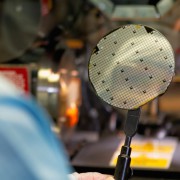Raytheon and Rolls Royce develop SiC diodes for lightning protection
Raytheon UK is lending its expertise in high-temperature silicon carbide (HiTSiC) to partner on a project that would provide aircraft electronics and wiring with a device to protect against lightning strikes.
The innovative project – led by Controls and Data Services (part of the Rolls-Royce Group) and which also includes Newcastle University in the role of design authority and TT Electronics Semelab – is exploring the use of Raytheon’s and Newcastle University’s HiTSic technology to make Current Limiting Diodes (CLDs); a new kind of lightning protection device which stands to reduce the amount of electrical energy traditional suppressors have to deal with during a lightning strike.
“With today’s composite materials replacing metallic components and skin materials, the reduced electrical screening in airframes is forcing a rethink of lightning protection architectures,” said John Kennedy, head of Raytheon UK’s Integrated Power Solutions.
“Current Limiting Diodes will essentially absorb much of the electrical energy that the dampening device would otherwise have to channel during a lightning strike.”
The two-phase project, funded under Innovate UK, is currently in phase one; Newcastle University is conducting electrical characterization tests while TT Electronics Semelab develops the CLD packaging.
With the project expected to be completed by late 2015, Raytheon UK’s innovative high-temperature silicon carbide solution to guard against lightning strikes will soon be the eye in the storm.
More info here










Leave a Reply
Want to join the discussion?Feel free to contribute!